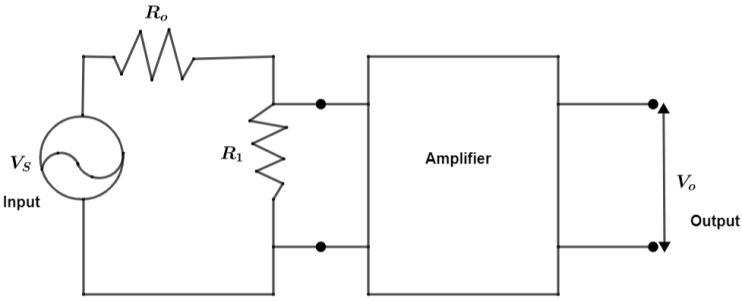
In an arrangement to amplify an audio signal, the amplifier used has a voltage gain of A.V. for an input supply V.S., the output voltage ${{V}_{\text{o}}}$ will be

$\left( a \right){{V}_{o}}={{A}_{v}}\times {{V}_{s}}$
$\left( b \right){{V}_{o}}={{A}_{v}}{{V}_{s}}\dfrac{{{R}_{1}}}{{{R}_{o}}}$
$\left( c \right){{V}_{o}}=\dfrac{{{A}_{v}}{{V}_{s}}{{R}_{1}}}{{{R}_{o}}+{{R}_{1}}}$
$\left( d \right){{V}_{o}}={{A}_{v}}{{V}_{s}}\times \dfrac{{{R}_{o}}}{{{R}_{s}}}$

Answer
476.4k+ views
Hint: With the use of formula of average gain and potential difference we will be able to find the solution. For this we will substitute correct values in the formulas by clearly understanding the symbols used in the diagram.
Formula used:
${{A}_{v}}=\dfrac{{{V}_{output}}}{{{V}_{input}}}$, where ${{A}_{v}}$ is a voltage gain and ${{V}_{output}},{{V}_{input}}$ are output and input voltages respectively, $V=IR$ is the formula of potential difference where I is current and R is resistance.
Complete answer:
Amplifier: It is used in those electronics in which it is important to high the tone of input. For this case we use an amplifier which delivers input of the sound into modified and highly tuned output.
Voltage gain: Voltage gain is the value of how much the sound is giving high output. This can be measured by just calculating the amount of voltage that is gained from the input circuit. If we take for example a radio then we will check for its voltage gain value so as to find how loud it can gain the output of input it receives.
Since, the voltage gain is denoted by ${{A}_{v}}$ whose value is equal to $\dfrac{{{V}_{output}}}{{{V}_{input}}}$ which we come to know that the units of ${{V}_{output}}=V$ and ${{V}_{input}}=V$. So, both the units will get cancelled due to be in the form of a ratio. Thus, this implies that voltage gain is a unit less quantity. The voltage gain has a property of input voltage proportional to output voltage. That is, if we increase input then, we will get increased output and vice versa.
Potential difference: The potential difference between any two points in a circuit is measured by the help of potential difference. The formula of this is $V=IR$.
So, accordingly the potential difference of ${{R}_{1}}$ is,
$\begin{align}
& {{V}_{{{R}_{1}}}}=I{{R}_{1}} \\
&\Rightarrow{{V}_{{{R}_{1}}}}=\left(\dfrac{{{V}_{s}}}{{{R}_{1}}+{{R}_{\text{o}}}}\right){{R}_{1}}\,\,\,\,\,\left( \because I=\dfrac{{{V}_{s}}}{{{R}_{1}}+{{R}_{\text{o}}}} \right) \\
\end{align}$
This result into,
$\begin{align}
& {{V}_{\text{o}}}={{A}_{v}}\times {{V}_{{{R}_{1}}}} \\
& \Rightarrow {{V}_{\text{o}}}={{A}_{v}}\dfrac{{{V}_{s}}{{R}_{1}}}{{{R}_{1}}+{{R}_{\text{o}}}} \\
\end{align}$
So, the correct answer is “Option C”.
Note:
The following points are taken into consideration then; it will be easy to solve the questions:
(1) The formula of Voltage gain: ${{A}_{v}}=\dfrac{{{V}_{output}}}{{{V}_{input}}}$.
(2) Proportionality of input-output should be known. This means that they are directly proportional to each other.
(3) There are uses of amplifiers in our day to day lives such as T.V., radio and so on.
(4) It is important to draw the right diagram for amplifiers and voltage gain otherwise, circuit will be wrong.
Formula used:
${{A}_{v}}=\dfrac{{{V}_{output}}}{{{V}_{input}}}$, where ${{A}_{v}}$ is a voltage gain and ${{V}_{output}},{{V}_{input}}$ are output and input voltages respectively, $V=IR$ is the formula of potential difference where I is current and R is resistance.
Complete answer:
Amplifier: It is used in those electronics in which it is important to high the tone of input. For this case we use an amplifier which delivers input of the sound into modified and highly tuned output.
Voltage gain: Voltage gain is the value of how much the sound is giving high output. This can be measured by just calculating the amount of voltage that is gained from the input circuit. If we take for example a radio then we will check for its voltage gain value so as to find how loud it can gain the output of input it receives.
Since, the voltage gain is denoted by ${{A}_{v}}$ whose value is equal to $\dfrac{{{V}_{output}}}{{{V}_{input}}}$ which we come to know that the units of ${{V}_{output}}=V$ and ${{V}_{input}}=V$. So, both the units will get cancelled due to be in the form of a ratio. Thus, this implies that voltage gain is a unit less quantity. The voltage gain has a property of input voltage proportional to output voltage. That is, if we increase input then, we will get increased output and vice versa.
Potential difference: The potential difference between any two points in a circuit is measured by the help of potential difference. The formula of this is $V=IR$.
So, accordingly the potential difference of ${{R}_{1}}$ is,
$\begin{align}
& {{V}_{{{R}_{1}}}}=I{{R}_{1}} \\
&\Rightarrow{{V}_{{{R}_{1}}}}=\left(\dfrac{{{V}_{s}}}{{{R}_{1}}+{{R}_{\text{o}}}}\right){{R}_{1}}\,\,\,\,\,\left( \because I=\dfrac{{{V}_{s}}}{{{R}_{1}}+{{R}_{\text{o}}}} \right) \\
\end{align}$
This result into,
$\begin{align}
& {{V}_{\text{o}}}={{A}_{v}}\times {{V}_{{{R}_{1}}}} \\
& \Rightarrow {{V}_{\text{o}}}={{A}_{v}}\dfrac{{{V}_{s}}{{R}_{1}}}{{{R}_{1}}+{{R}_{\text{o}}}} \\
\end{align}$
So, the correct answer is “Option C”.
Note:
The following points are taken into consideration then; it will be easy to solve the questions:
(1) The formula of Voltage gain: ${{A}_{v}}=\dfrac{{{V}_{output}}}{{{V}_{input}}}$.
(2) Proportionality of input-output should be known. This means that they are directly proportional to each other.
(3) There are uses of amplifiers in our day to day lives such as T.V., radio and so on.
(4) It is important to draw the right diagram for amplifiers and voltage gain otherwise, circuit will be wrong.
Recently Updated Pages
Master Class 12 Economics: Engaging Questions & Answers for Success

Master Class 12 Maths: Engaging Questions & Answers for Success

Master Class 12 Biology: Engaging Questions & Answers for Success

Master Class 12 Physics: Engaging Questions & Answers for Success

Master Class 12 Business Studies: Engaging Questions & Answers for Success

Master Class 12 English: Engaging Questions & Answers for Success

Trending doubts
Which are the Top 10 Largest Countries of the World?

Differentiate between homogeneous and heterogeneous class 12 chemistry CBSE

Draw a labelled sketch of the human eye class 12 physics CBSE

What is the Full Form of PVC, PET, HDPE, LDPE, PP and PS ?

What is a transformer Explain the principle construction class 12 physics CBSE

What are the major means of transport Explain each class 12 social science CBSE




